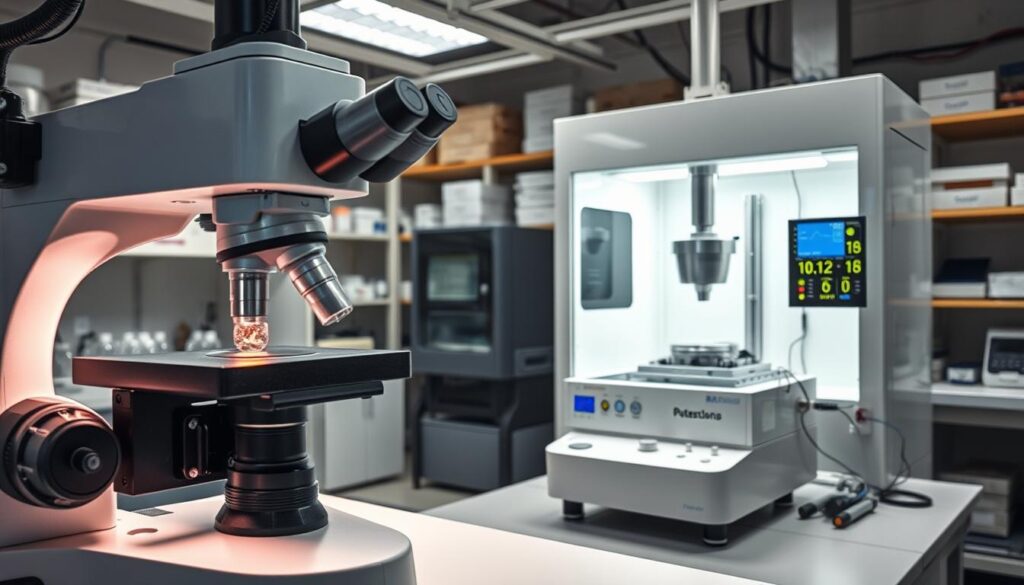You might know that new innovative technology is changing many industries around the world.
New element materials technology is changing how we design, make, and use products. It’s a big change.
When you look into element materials technology, you’ll see the newest discoveries. These are making a big difference in many areas.
Key Takeaways
- Understanding the role of element materials technology in driving innovation.
- Exploring the latest advancements in materials science.
- Discovering how innovative technology is transforming industries.
- Learning about the applications of element materials technology.
- Gaining insights into the future of materials technology.
The Fundamentals of Materials Science and Technology

At the heart of technological advancements lies the science of materials. Understanding materials science is key for developing new solutions in many industries. It studies the properties and uses of different materials to make new products and technologies.
Core Principles That Drive Materials Innovation
Materials innovation comes from knowing how materials are structured, what properties they have, and how they are made. By changing these, scientists can create advanced materials with special properties, like superconductors or nanomaterials.
How Materials Testing Transforms Industries
Materials testing is vital for checking the quality and reliability of materials used in many areas. Methods like tensile testing and fatigue analysis help find out what materials can do. This lets industries make smart choices. Here’s a table showing common testing methods and where they’re used:
| Testing Technique | Application | Industry |
|---|---|---|
| Tensile Testing | Measures material strength | Aerospace, Automotive |
| Fatigue Analysis | Evaluates material durability | Construction, Aerospace |
| Hardness Testing | Assesses material resistance | Manufacturing, Construction |
How to Identify the Right Element Materials Technology for Your Project

Starting a new project means picking the right Element Materials Technology. You need to know what your project needs and find the best technology for it.
Assessing Your Material Requirements
To find the right Element Materials Technology, start by looking at what your project needs. Think about the mechanical properties, thermal resistance, and chemical stability needed. Also, consider the environmental impact and cost-effectiveness of the materials.
- Determine the functional requirements of your project.
- Evaluate the performance criteria for the materials.
- Consider the scalability and manufacturability of the materials.
Matching Technologies to Application Needs
After figuring out what your project needs, match the technologies to those needs. Understand what different engineering materials and materials testing methods can do. For example, advanced materials like nanomaterials or composites might have great properties but need special testing.
- Research available Element Materials Technologies.
- Compare the features and benefits of different technologies.
- Select the technology that best aligns with your project requirements.
Step-by-Step Guide to Materials Selection
Choosing the right materials is key to a project’s success. A careful selection process ensures your project meets its goals. This includes performance, safety, and staying within budget.
Defining Performance Criteria
To begin, you must define the performance criteria for your project. This means identifying what the material needs to do. Look at strength, durability, and how it handles the environment.
Evaluating Material Properties
Then, evaluate the properties of possible materials. Check their mechanical, thermal, and electrical properties. This helps you pick the best material for your needs.
Cost-Benefit Analysis Techniques
Lastly, do a cost-benefit analysis to see if the material is worth it. Think about the upfront cost and long-term savings. Important things to look at include:
- Initial material cost
- Installation and processing costs
- Maintenance and repair costs
- Potential for recycling or reuse
By following these steps, you can make a choice that balances what you need and what you can afford.
Implementing Advanced Testing Methodologies
To make sure cutting-edge materials work well, we need to test them carefully. In the world of materials science, it’s key to know how to test, prepare samples, and analyze data.
Setting Up Your Testing Protocol
Creating a strong testing plan is important. First, figure out what material properties matter most for your project. This could be strength, how well it conducts heat, or how it holds up against corrosion. Using standardized testing methods from groups like ASTM or ISO helps keep things consistent and comparable.
Sample Preparation Best Practices
Getting samples ready right is crucial for good test results. Think about sample shape, surface quality, and how you handle the material. It’s important to make sure samples really show what the material is like in real use.
Data Collection and Analysis Methods
Getting and analyzing data well is key in materials testing. Use advanced data analytics to understand test results, spot patterns, and guess how materials will act in different situations. Tools like statistical models and machine learning can help make sense of the data.
| Testing Methodology | Application | Key Benefits |
|---|---|---|
| Tensile Testing | Evaluating material strength and ductility | Provides critical data for design and simulation |
| Thermal Analysis | Assessing thermal properties and stability | Helps predict material behavior under thermal stress |
| Corrosion Testing | Evaluating resistance to environmental degradation | Essential for predicting long-term material performance |
By using these advanced testing methods, we can really understand our materials. This helps us make smart choices to improve how they work and where they can be used.
How to Leverage Nano-Materials in Engineering Applications
Nano-materials are changing how we design and make products. They add strength, conductivity, and durability. This leads to new ideas in fields like aerospace and electronics.
Identifying Suitable Nano-Material Solutions
Finding the right nano-materials is key. You need to know their properties and how they fit your needs. For example, carbon nanotubes are strong and conduct electricity well.
Match your project’s needs with nano-material properties. This way, you pick the best material for your project.
Integration Techniques for Enhanced Performance
After picking the right nano-material, you need to add it to your product. Methods like dispersion, coating, and making composites are used. For example, adding nano-particles to polymers makes them stronger.
Using the right methods, you can make your product better. It will work better and last longer.
Navigating Regulatory Compliance and Certification
In materials science, following rules is key to success. It’s not just about doing the right thing; it’s a way to stand out. Knowing the rules helps your project thrive.
Compliance means your materials are safe, work well, and don’t harm the environment. In the U.S., groups like the American Society for Testing and Materials (ASTM) and the International Organization for Standardization (ISO) set these standards.
Meeting Industry-Specific Standards
Each field has its own rules. For example, aerospace materials face extreme conditions. You must find the right standards for your field, like aerospace, automotive, medical devices, or consumer electronics.
| Industry | Regulatory Body | Key Standards |
|---|---|---|
| Aerospace | ASTM, AS9100 | Material strength, durability, and resistance to extreme temperatures |
| Automotive | ISO/TS 16949, SAE | Material durability, safety, and performance under various conditions |
| Medical Devices | ISO 13485, FDA | Biocompatibility, sterilizability, and material stability |
Documentation and Validation Processes
After finding the right standards, you must test and document your materials. This means showing how your materials meet the standards through testing and validation.
Good documentation helps you follow rules and improve your work. It shows how your materials perform and where they can get better. Make sure your documents are complete, easy to find, and follow your industry’s rules.
Troubleshooting Material Performance Issues
Understanding why materials fail is key to fixing problems. In materials science, we look at the material’s properties, the environment it’s in, and the stresses it faces.
Diagnosing Common Failure Modes
Figuring out why materials fail needs a careful plan. Issues like corrosion, fatigue, and wear are common. Corrosion, for example, can happen when materials meet harsh chemicals or moisture.
To find these problems, we check the material’s surface and inside. Important tools include:
- Microscopy to see surface damage
- Chemical analysis to spot corrosive agents
- Mechanical testing to check material strength
Implementing Effective Solutions
After finding the problem, we need to fix it. This might mean changing the material, designing it differently, or adding a protective layer. For corrosion, a corrosion-resistant coating can really help.
Testing the material is crucial to make sure it works well. Materials testing helps us check if our fixes work under different conditions.
Real-World Applications of Element Materials Technology
Element Materials Technology is changing the game in many fields. It’s not just a theory; it’s real and making a big impact. It’s helping to solve big problems and drive new ideas in different areas.
Case Studies in Aerospace and Automotive Industries
The aerospace and automotive fields are getting a big boost from Element Materials Technology. For example, new materials are making cars more fuel-efficient and cleaner. In planes, these materials are making parts stronger and better.
Innovations in Medical and Consumer Electronics
In medicine, innovative technology from Element Materials is leading to new medical tools and implants. Also, gadgets are getting better thanks to advanced materials. These improvements show how versatile and powerful Element Materials Technology is.
Conclusion: Embracing the Future of Materials Innovation
Exploring Element Materials Technology opens up a world where cutting-edge materials are key. They will shape the future of many industries. The work in this field is leading to new materials with special properties for different uses.
Learning about materials science and technology helps you choose the right materials. Advanced testing methods also play a big role. This way, you can lead the way in innovation and performance.
As research advances, we’ll see Element Materials Technology in new areas. This includes aerospace, automotive, medical, and consumer electronics. Keeping up with these changes will open doors to success and new opportunities.
FAQ
What is Element Materials Technology, and how does it impact various industries?
Element Materials Technology is a leading provider of materials testing and research services. It helps industries like aerospace, automotive, and consumer electronics. They ensure the quality and reliability of materials, driving innovation and reducing material failure risk.
How do I choose the right materials testing methodology for my project?
To pick the right testing method, first, assess your material needs. Then, consider the properties you must measure. Choose a protocol that fits your application needs. Remember to think about sample preparation, data collection, and analysis for accurate results.
What are the benefits of using nano-materials in engineering applications?
Nano-materials have unique properties like enhanced strength and conductivity. They are great for energy storage, medical devices, and consumer electronics. Using nano-materials can lead to innovative products with better performance and efficiency.
How do I ensure regulatory compliance and certification for my materials?
To meet regulations, follow industry standards and maintain accurate records. Understand relevant regulations and show compliance through testing and certification. This ensures your materials are safe and meet performance standards.
What are some common material performance issues, and how can I troubleshoot them?
Common issues include failure due to mechanical stress, corrosion, or degradation. To troubleshoot, diagnose the failure cause through testing and analysis. This helps you find effective solutions, like material selection or design changes, to fix the issue.
How can I stay up-to-date with the latest advancements in materials science and technology?
Stay current by attending conferences, joining research collaborations, and following leading companies like Element Materials Technology. This way, you’ll know about new discoveries and innovations in materials science and technology.
What role does cost-benefit analysis play in materials selection?
Cost-benefit analysis is key in materials selection. It helps you weigh material properties, performance, and cost. By doing a thorough analysis, you can make informed decisions that balance technical needs with budget constraints, ensuring cost-effective material selection.
How can I integrate advanced materials into my product design?
To integrate advanced materials, first, assess your material needs. Then, identify suitable materials and evaluate their properties. Consider manufacturability, cost, and regulatory compliance to ensure your product meets specifications and requirements.




